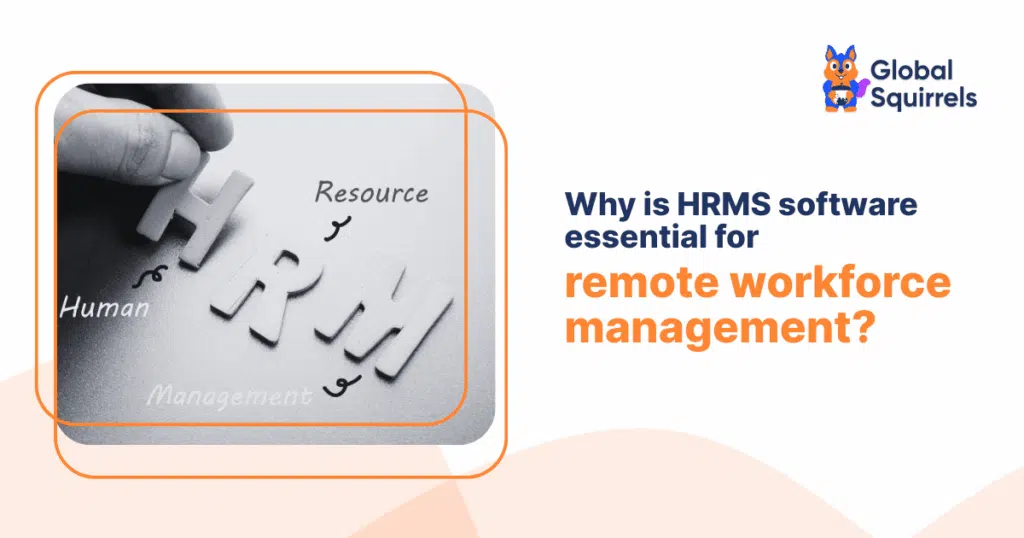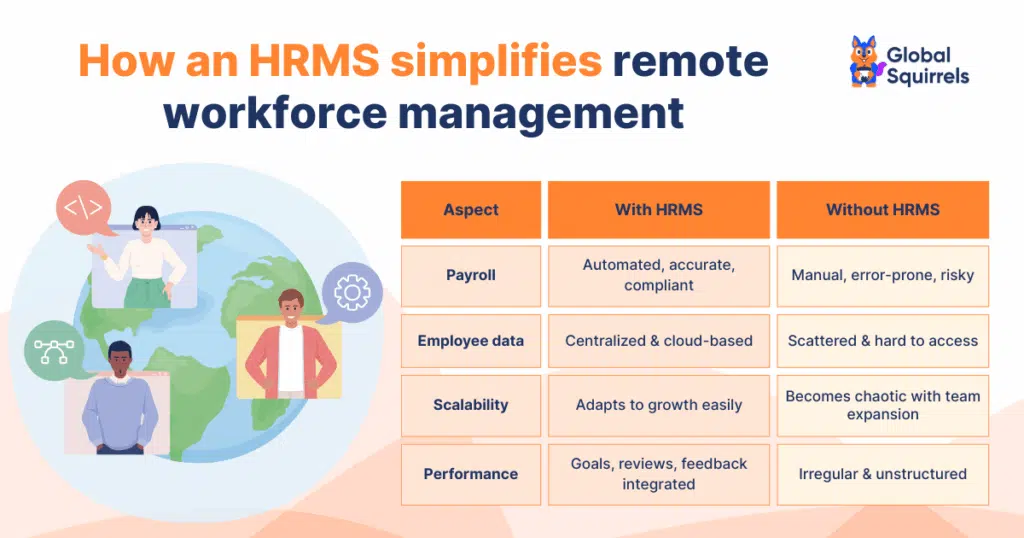Why is HRMS essential for remote workforce management?

The way businesses work has greatly transformed in the last few years. Remote and hybrid working models are becoming new standards across industries. While this shift will offer employees flexibility and businesses access to a huge pool of talent, it will also present unique challenges in workforce management. From tracking productivity and ensuring compliance to managing attendance, payroll, and employee engagement, HR teams will face increasing pressure to keep the operations seamless in a distributed setup.
This is where the Human Resource Management System serves as a remote workforce software, playing a crucial role. By automating routine tasks, centralizing employee data, and facilitating seamless communication among managers and teams, HRMS will empower operations to effectively manage their remote workforce. More than just an administration tool, it has become a strategic enabler that will ensure transparency, efficiency, and employee satisfaction, irrespective of where the team is located.
What is an HRMS?
A human resource management system is an all-in-one solution that will help businesses automate and streamline the HR processes. Instead of managing the employee records, attendance, payroll, and performance manually across multiple tools, HRMS will bring everything together in a single, centralized platform.
A modern HRMS will go beyond basic administration; it will empower HR teams to manage the entire lifecycle of the employee, ranging from recruitment, payroll, compliance, performance reviews, and even the exit processes. With a built-in self-service feature, employees can access payslips, apply for leave, update personal details, and stay connected with the teams, which will reduce the dependency on HR for routine activities.
For organizations managing remote or hybrid teams, remote workforce management software will become quite essential. Cloud-based systems will allow HR managers and employees to access important data anytime, anywhere, which will ensure seamless communication, accurate payroll, and better compliance, irrespective of the location of the workforce.
Challenges of managing a remote workforce without HRMS
While remote work offers flexibility and access to a wide talent pool, it also presents challenges for businesses that do not utilize an HRMS. Without a central system, HR teams will find themselves juggling between various tools, spreadsheets, and manual processes, which could quickly cause inefficiencies and employee dissatisfaction. Some of the most common challenges include:
1. Difficult to track attendance and productivity
Managing the work hours and attendance of the employees is quite complicated in a remote environment. Manual tracking methods will result in inaccurate records, delays in approving leaves, and time theft, which will directly affect payroll accuracy and workforce planning.
2. Collaboration and communication gaps
In the absence of an integrated HR system, employees and managers will rely on scattered chat or email tools to manage any HR related issues. This will create confusion, slow down the approvals, and make the employees feel disconnected from the organization.
3. Compliance risks and payroll errors
Remote teams will span across multiple locations, time zones, and countries. Handling payroll manually for such a huge workforce will increase the risk of miscalculations, delays, and non-compliance with labor laws or tax regulations, issues that can actually damage employee trust and expose the company to various legal penalties.
4. Employee engagement and issues with retention
Keeping the remote employees engaged and motivated without the HRMS-driven tools like feedback systems, performance tracking, or recognition programs can be a challenge. Lack of visibility into career progression can lead to reduced productivity, higher attrition rates, and less engagement.
Why is an HRMS crucial for remote workforce management?
Managing a distributed workforce will need more than just the basic HR tools. It will require a system that will bring structure, accountability, and transparency to the daily operations. Modern HRMS will come equipped with features that are tailored to the specific needs of remote and hybrid teams. Some of the most impactful ones will include:
1. Automated payroll and compliance management
Remote teams will often operate across multiple states or countries with changing tax laws and labor regulations. HRMS will automate tax deductions, statutory filings, and payroll calculations, which reduces errors while ensuring full compliance with local regulations.
2. Attendance and time tracking
Traditional attendance systems for remote workers do not suffice. HRMS will provide digital login abilities, leave management features, thus enabling the HR teams to access accurate visibility into employee activities.
3. Feedback and performance management
Progress tracking, setting goals, and periodic performance review can be managed digitally within an HRMS. A constant feedback system and performance dashboard will keep employees in alignment with business objectives even across borders.
4. Employee self-service portals or ESS
Via ESS portals, remote employees can directly download payslips, update personal data, request leaves, and check policy documents. This will reduce the burden on HR teams and will empower employees with higher control over the data.
How to choose the right HRMS for your organization?
With so many HRMS platforms available, selecting the right fit for your business can get confusing. The right choice depends on factors like the size of the organization, structure, and long-term goals. Some of the key points to consider when making your decision are:
1. Identify the needs of the business
Begin by mapping out the HR challenges. Figure out if you need stronger payroll management, compliance support, or better engagement tools for remote workers. A clear understanding of this will help you shortlist platforms that align with your goals.
2. Check for cloud accessibility
For hybrid and remote teams, a cloud-based HRMS is important. Ensure the platform provides anytime, anywhere access, enabling HR teams and employees to stay connected seamlessly.
3. Ease of use
An HRMS is only effective if people actually utilize it. Choose a platform with an easy-to-use interface and self-service capabilities so employees can access payslips, apply for leave, or update details without constant HR intervention.
4. Integration capabilities
Check if the HRMS integrates with the existing tools like payroll processes, accounting software, communication platforms, or project management tools. Smooth integration will reduce duplicate work and ensure data consistency.
Key business advantages of HRMS for remote workforce management
Implementing an HRMS is more than just digitizing HR related activities. It will transform the way organizations manage and engage with remote employees. By combining transparency, accessibility, and automation, HRMS will offer various advantages for remote teams:
1. Improved productivity and efficiency
Routine HR activities, ranging from attendance tracking to payroll processing, are all automated, thus saving time for the HR teams and employees. This will allow the HR to focus on strategic initiatives while also ensuring remote workers will get a fast and accurate resolution to their requirements.
2. Improved engagement from the employee
Features like performance reviews, recognition tools, and self-service portals will empower employees to stay connected with the work and the organization. By giving them visibility into the growth and access to resources, HRMS will foster a sense of belonging.
3. Increased trust and transparency
With clear digital records of attendance, performance, and payroll, employees will have confidence that processes are fair and unbiased. This transparency is important in a remote environment where a lack of physical reports can create doubts.
4. Reduced risk and increased compliance
HRMS will ensure taxes, payroll, and labor regulations are being followed accurately across multiple locations. This will protect organizations from expensive errors, legal issues, and penalties while building credibility with remote employees.
5. Easy to scale growing teams
HRMS can scale a company with a varying number of employees. As businesses expand globally, the system will adapt to new structures, policies, and compliance requirements without any disruption.
Conclusion: Remote employee success from startups to enterprises
In conclusion, remote work has created tons of opportunities for businesses of every size, but it has also introduced new challenges in managing compliance, managing people, and productivity. An HRMS will bridge the gap by offering the right mix of transparency, scalability, and automation. With lean teams and limited resources, startups usually cannot afford to spend hours on manual HR tasks. An HRMS will help them automate payroll, onboarding, and compliance, which allows founders and small HR teams to focus on growth while also delivering a professional employee experience. As SMEs continue to expand, managing HR processes manually will become inefficient and error-prone. An HRMS centralizes employee data, handles leaves, and attendance tracking, which helps SMEs to retain talent while staying cost-efficient. Large organizations with a global workforce usually face complex issues in compliance and payroll. HRMS will ensure consistency across multiple regions, providing advanced analytics for workforce planning and keeping employees connected through scalable systems that work across thousands of users.

